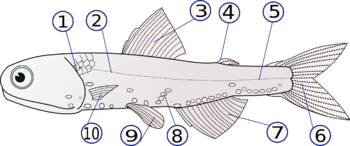
The anatomy of Lampanyctodes hectoris
(1) – operculum (gill cover), (2) – lateral line, (3) – dorsal fin, (4) – fat fin, (5) – caudal peduncle, (6) – caudal fin, (7) – anal fin, (8) – photophores, (9) – pelvic fins (paired), (10) – pectoral fins (paired)
As it is Good Friday I thought I would look into the association of fish with Christianity and religion in general. However, that turned out to be way too hard and full of potholes I just could not be bothered navigating around – and I’m trying to pack the swag for camping.
So, rather that concentrate on one fish I have “researched” Wikipedia for a description of all fish.
Here you go:
A fish is any member of a paraphyletic group of organisms that consist of all gill-bearing aquatic craniate animals that lack limbs with digits. Included in this definition are the living hagfish, lampreys, and cartilaginous and bony fish, as well as various extinct related groups. Most fish are ectothermic (“cold-blooded”), allowing their body temperatures to vary as ambient temperatures change, though some of the large active swimmers like white shark and tuna can hold a higher core temperature.
Fish are abundant in most bodies of water. They can be found in nearly all aquatic environments, from high mountain streams (e.g., char and gudgeon) to the abyssal and even hadal depths of the deepest oceans (e.g., gulpers and anglerfish). At 32,000 species, fish exhibit greater species diversity than any other group of vertebrates.
The earliest organisms that can be classified as fish were soft-bodied chordates that first appeared during the Cambrian period. Although they lacked a true spine, they possessed notochords which allowed them to be more agile than their invertebrate counterparts. Fish would continue to evolve through the Paleozoic era, diversifying into a wide variety of forms. Many fish of the Paleozoic developed external armor that protected them from predators. The first fish with jaws appeared in the Silurian period, after which many (such as sharks) became formidable marine predators rather than just the prey of arthropods.


30th March 2013 at 2:31 am
Here’s a hint for the religiously impaired…
The fish thing comes from the time when Christ was overseeing a gathering of the faithful. But they didn’t have enough food. All they had was seven loaves of bread and two fish (or is it the other way around).
But Christ wove a miracle and suddenly those few loaves and those few fish magically became enough to feed everyone.
And if you understand the story, it meant that what he did was he made those gathering feel at peace and see their fellow man with kindness and generosity, or see themselves with kindness and generosity. Obviously, those attending had more than a few loaves and a few fish. They had lots of food squirreled away. But they had dark feelings – either bitterness about being exploited (the haves) or a sense of shame for asking (the have nots). So the miracle was really the sense of goodness (cheesy, but there it is) penetrating into the hearts of those who believed.